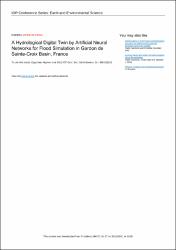| dc.contributor.author | İnan, Çağrı Alperen | |
| dc.contributor.author | Artigue, Guillaume | |
| dc.contributor.author | Kurtuluş, Bedri | |
| dc.date.accessioned | 2021-12-31T11:00:47Z | |
| dc.date.available | 2021-12-31T11:00:47Z | |
| dc.date.issued | 2021 | en_US |
| dc.identifier.uri | https://doi.org/10.1088/1755-1315/906/1/012112 | |
| dc.identifier.uri | https://hdl.handle.net/20.500.12809/9734 | |
| dc.description.abstract | Understanding, simulating and forecasting dynamic and nonlinear natural phenomena are necessary in a climate change context and increased sensitivity of societies to natural hazards. Nevertheless, even though powerful computing tools and algorithms have been widely used to understand and to predict natural disasters, these tasks are still challenging for scientists. Indeed, one of the most dangerous natural phenomena, flash floods keep being a challenge for modelers, despite (i) the existence of some effective hydrological simulating tools, and (ii) the increasing availability of descriptive data, especially rainfall and discharge. In particular, on one hand, environmental data contain an important amount of noise leading to additional uncertainties and on the other hand, physically based models strongly depend on assumptions about the behavior of the basin, that is often more variable in space and time than what is modelled. With the objective of applying data assimilation to improve forecasting properties of the physical model, it is necessary to dispose of a differentiable model. In order to mitigate this issue, a hybrid physical and statistical approach is proposed in this study. It was shown in previous works that deep neural networks are able to identify any differentiable function by using the universal approximation property. Deep neural networks are also good candidates to perform the digital twin of the physical model. Thus, three different neural networks models were designed in this study, and each one is implementing a different type of non-linear filter model, in order to achieve the dynamic character of the catchment area (recurrent, feedforward and static models). The study area is located in the Gardon de Sainte-Croix basin (France), which is known for its sudden and violent floods that caused casualties and a lot of damage. The chosen physical-based model is semi distributed conceptual hydrological SOCONT model, RS Minerve (https://www.crealp.ch/down/rsm/install2/archives.html). Neural networks design was done by using a rigorous complexity selection and regularization methods to promote a good generalization. The three models obtained were thus compared. The feed forward model gave the best results on tests events (Nash score=0.98-0.99), making full use of the inputs with previous observed discharges whereas the recurrent model gave interesting results representing satisfactorily the dynamics of the physical model (Nash score=0.8-0.97). The static model, whose inputs contain only rainfall, is less efficient, showing the importance of dynamics in that kind of system (Nash score=0.62-0.84). Beyond data assimilation, these results open paths of inquiry for building digital twins of physical model, allowing also a great reduction of computing time | en_US |
| dc.item-language.iso | eng | en_US |
| dc.publisher | IOP Publishing Ltd | en_US |
| dc.relation.isversionof | 10.1088/1755-1315/906/1/012112 | en_US |
| dc.item-rights | info:eu-repo/semantics/openAccess | en_US |
| dc.subject | Flood simulation | en_US |
| dc.title | A Hydrological Digital Twin by Artificial Neural Networks for Flood Simulation in Gardon de Sainte-Croix Basin, France | en_US |
| dc.item-type | conferenceObject | en_US |
| dc.contributor.department | MÜ, Mühendislik Fakültesi, Jeoloji Mühendisliği Bölümü | en_US |
| dc.contributor.authorID | 0000-0001-6646-9280 | en_US |
| dc.contributor.institutionauthor | İnan, Çağrı Alperen | |
| dc.contributor.institutionauthor | Kurtuluş, Bedri | |
| dc.identifier.volume | 906 | en_US |
| dc.identifier.issue | 1 | en_US |
| dc.relation.journal | IOP Conference Series: Earth and Environmental Science | en_US |
| dc.relation.publicationcategory | Konferans Öğesi - Uluslararası - Kurum Öğretim Elemanı | en_US |


















